Biography

By Auguste Jouve in 1878.

In Auguste Jouve's studio.
Paul Jouve was born March 16th, 1878 in Bourron-Marlotte in the Department of Seine et Marne, France. His father, Auguste Jouve, born in Lyon on July 11th, 1846, was a graduate of the Beaux-Arts School in Lyon, a painter and friend of Theo and Vincent Van Gogh. The Van Gogh Museum in Amsterdam has three of his paintings.
Auguste Jouve was a portrait painter, landscape painter and ceramist, with a passion for photography that he passed on to his son who, as an adult, after having used his father’s large format ‘Bellini’ camera, would never be seen without his "Leica" on his numerous trips. Auguste Jouve was awarded a gold medal at the Universal Exposition in Paris in 1899. The animal painter Olivier de Penne who lived in the Verger in Bourron-Marlotte was the witness at Auguste Jouve’s marriage. This closeness no doubt influenced Paul Jouve’s taste for animal representations.
Paul Jouve was two years old when his father moved to Paris, on the boulevard Saint Jacques.

Pencil drawing, circa 1894.

Pencil and Indian ink, circa 1898.
Very early Auguste Jouve noticed his son’s taste for drawing, his practicing drawing his cat. Jouve’s father encouraged him in this path, taking him to museums and the Jardin des Plantes where the boy acquires a passion for wild animals he then practices drawing.
His father enrols him in the School of Decorative Arts where, little motivated by the academic exercises, he stays only one year. He attends courses at the Beaux Arts School on the rue Bonaparte as an "independent student", but still prefers drawing from life.
So he constantly frequents the Jardin des Plantes, the horse market and the slaughterhouses near his father’s atelier, finding an inexhaustible source of models. To perfect his anatomical knowledge he frequents the museum of Natural History and the veterinary school in Maisons Alfort. Very early Jouve is interested in the different reproduction techniques. He becomes initiated in lithography in the studio of one of his father’s friends: the lithographer Henry Patrice Dillon. His whole life Jouve will hold a limitless admiration for Flemish engravers, whose works he will go see and see again in museums each time he visits Holland and Germany.

Chartres Cathedral, 1898.

Plaster, for the 1900 exhibition.
Guillot's workshop.
Paul Jouve is only sixteen years old when he exposes for the first time at the Salon for the Society of French Artists and his arrival on the scene is noticed. The Ménélik lions he draws at the Jardin des Plantes, with their academic construct, are of excellent quality. The same year he makes and sells his first lithographs. Afterward he will participate each year in this Beaux Arts exhibition.
In September 1898 he is in Chartres completing his military service, in the 130th infantry regiment where he meets Georges Leroux , it will be the beginning of a very long friendship.
For The exposition universelle in 1900 , the architect Binet, commissions Jouve to create a frieze of wild animals 100 meters long with tigers, bears, lions, bulls and, wild mountain sheep. This frieze is executed in greenish brown enamelled flambé sandstone by Alexandre Bigot. Another commission from Binet: this time four lions to decorate the main entrance way to the Champs Elysées, between the two palaces, as well as a monumental statue representing a coq with it’s wings spread, which will be placed on top of the arch of the main gate leading to the Exposition. The 1900 Exposition Universelle marks the beginning of his renown. Bigot will edit and commercialise the different bas relief making up this frieze, first life size, then in miniature, up until 1914.

N ° 34 of November 23, 1901
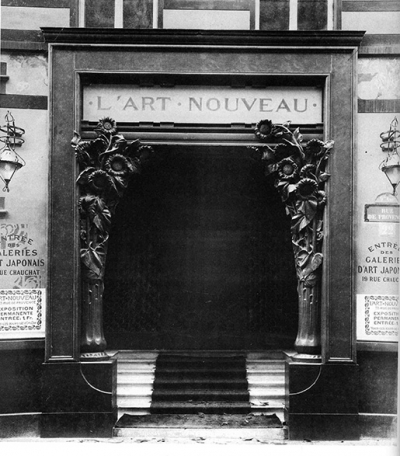
The new art
Entrance rue de Provence
In 1901, his nascent fame allows him to publish drawings in the satirical publication l'Assiette au Beurre, using animals for his caricatures. He will illustrate the whole November 23rd issue entitled "Social Revenge", in which he denounces the death penalty, militarism, deportations, torture in Russia, massacres in China, French justice and the reactionary bourgeoisie.
He will be noticed by the collector and dealer Samuel Bing, specializing in Oriental antiquities, who has been at the origin of Japonism at the end of the 19th century. As of 1902, Samuel Bing and his son Marcel, owner and founder of the gallery "L’Art Nouveau" at 22 rue de Provence, support Jouve, giving him the space to expose his drawing, paintings, engravings, decorative objects in Limoges porcelain, leatherworks and small bronzes. Jouve’s creations are met with wide success. The Gallery Bing’s financial aide will allow him to regularly visit the best zoos in Europe. In 1904 he will spend time in Hambourg, where the zoo fascinates him. Next it will be the zoo in Anvers and his meeting with Rembrandt Bugatti. The two artists will strike up a real friendship which will last until Bugatti’s tragic death.

Villa Abd-el-Tif, in Algiers, 1908.

Villa Abd-el-Tif, in Algiers, 1907.
1905 confirms Jouve’s fame and his regular participation in all the grand salons of the period. In March 1905, Marcel Bing will organize Jouve’s first big one man show in his new Gallery on the rue Saint Georges. The exposition will be a huge success.
In July The Society of Contemporary Books commissions him to illustrate Rudyard Kipling’s Jungle Book. The same year he exposes works in the sculpture section at the Salon of the National Society des Beaux Arts.
In 1907 Jouve, winner of a grant from the general government of Algeria, will be, along with Léon Cauvy the first resident at the Villa Abd-el-Tif in Algiers . He will meet his future wife Annette Noiré, daughter of the orientalist painter Maxime Noiré, through whom Jouve discovers Southern Algiers and the Bou Saada region, where he will find Etienne Dinet. He will bring back a great quantity of drawings and paintings from this trip.
Back in Paris shows will follow one after the other. In 1911 Jouve will move into the painter Gérome’s old atelier, on the rue Notre Dame des Champs and remain there until his death. Up until he is mobilized in August 1914, the number of one man shows and collective exhibitions grows along with his success.
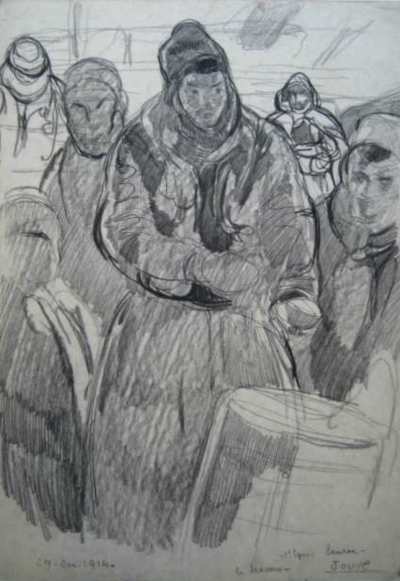
Stable, December 29, 1914.

Pencil, December 24, 1914.
Mobilized, Jouve, will be sent to the front in northern France, he will experience the trenches and the mud. As soon as he’s given a moment to catch his breath, Jouve will be found drawing. Through his drawings which are situated and dated it will be possible to follow his journey.
The colonel commanding the brigade notices his sketches and mentions them to the General of the Regiment. Genéral Quinquandon is an art lover, he will call Jouve to his headquarters to draw up the plans of the trenches, naming him sergeant in charge of mail delivery and taking him under his wing. On April 22nd 1915 Jouve survives the first battle in which asphyxsiating gases are used. This will be one of the most traumatizing moments in his life that he will share with Gaston Suisse; both men will remain profoundly marked by this horror.
In October of 1915 Jouve will rejoin his regiment in Salonica, Greece, to depart with the Army of the Orient. Thanks to support from General Quinquandon, he will find himself working at army headquarters commanded by General Sarrail, employed in the army’s photographic department. This assignment will allow him to draw and paint without having to fight.

Army of the East, Salonika.

Pencil and ink on paper.
At French headquarters, he will meet Prince Alexandre of Serbia, who likes his drawings. Prince Alexandre, the future king of Serbia will become his protector and friend and one of his most loyal clients, thus introducing him to the Europeen Gotha. Captain Abrami who was the head of Clemenceau’s cabinet will introduce him to "the tiger", who will also later become a client. He will also meet the Comte de Ramsay, who will become the Admiral commanding the fleet during the landing on June 6th, 1944 and the head doctor Rivet who will become deputy, general counsellor, professor and director of the Musée de l’Homme (Natural History Museum)
Paul Jouve will stay for two months on the peninsula of Athos, visiting the monasteries one by one, marvelling at the Byzantine treasures amassed by the monks over centuries. He will bring back from his stay in Mont Athos dozens of paintings and drawings, of a striking force and beauty.
Appointed the person in charge of artists from the Orient, he will organize in Athens an exposition that will have strong repercussions. The Athens exhibition’s quick success marks a turning point in his career: he writes : " from now on a clean sweep of the past, progress non stop, produce, no longer to be influenced by what is seen in museums or elsewhere."

Terraces of Bayon d'Angkor Thom, November 1923

Angkor Wat, November 1923.
Back to France, demobilized, Jouve is now a well know artist. The Jungle Book, the publication having been delayed because of the war, will appear finally and will know an enormous success. Prestigious orders will flood in. The Queen of Roumania and the European gotha will become faithful clients. He will be awarded the "Knight of the Legion of Honour" in 1920.
His marriage will not resisted the separation due to the war and his wife will go back to live in Algiers with his son Romain, Jouve will divorce in 1921, and marry Marguerite Jeanne Macqueron that spring. At the end of the year, in December, the first exposition of the Group of 4 will take place.
Click to enlarge Click to enlarge Winner of a travel grant from the government of Indochina, he prepares an important journey in the Far East. In 1922, at the end of the summer, as painter on a mission representing France, he will board ship in Marseille with his new wife for a long journey that will last eleven months and lead him to Indochina, China, Ceylan, and then on to India.

Citadel of Hue, February 1923.

Saigon Zoo, March 1923.
He will stay in Angkor nearly three months, fascinated by the beauty and grandeur of the site. He will return from this trip with hundreds of studies that will serve, among other things, to illustrate Lotti’s ‘Un Pelerin d’Angkor. The years following his return will be marked by this voyage.
Click to enlarge Click to enlarge His second son, Hubert, will born on his return from Asia, but he will separate once again from his wife and divorce the following year.
Expositions follow one after the other, always acclaimed by the critics. Jouve will present compositions brought back from Asia; he is at the peek of his art.
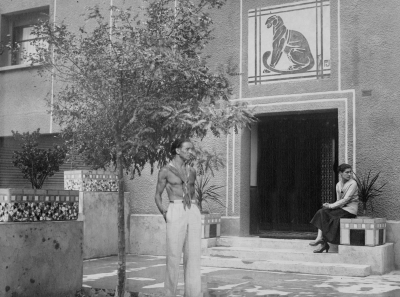
Bas relief with the panther, above the entrance.
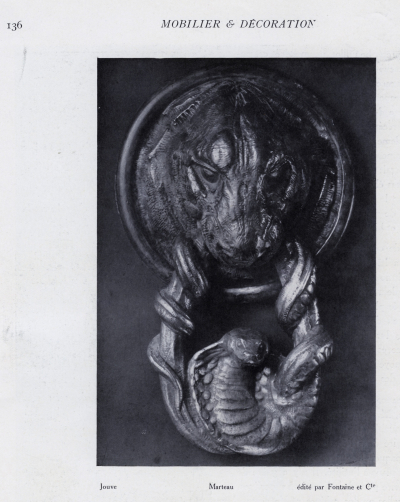
Furniture and Decoration, 1926.
Reproduced on page 136.
He has built, at great cost, a contemporary house in typical Art Déco style in Tholonet, near Aix en Provence, with a magnificent view of the Montagne Sainte-Victoire and where he will produce a splendid bas relief representing a sitting black panther to ornate the pediment of the main entrance. He stays there regularly up until the 50s.
In 1925 he will be awarded the Gold Metal at the International Exposition of Decorative Arts for a decorative panel exposed in the pavilion of applied arts and at the same time other works of his will be presented in diverse other pavilions, chez Fontaine where he exposes a door knocker, and in numerous stands where decorators present his sketches.
In 1926, Jouve will be named Officer of the Legion of Honor.
At the height of his glory, Jouve illustrates ‘Les fables de la Fontaine’, ‘Hunting’ by Kaa, ‘Les Poèmes Barbares’, ‘Un Pelerin d’Angkor' and ‘Les Paradis Terrestres’.

Oil on canvas by Paul Jouve.
State commission.
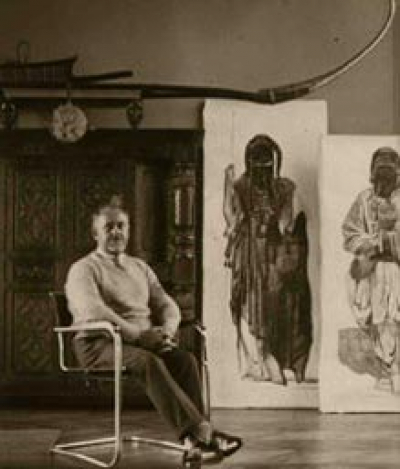
At the beginning of the year 1931, he will leave on a trip to Africa lasting several months, to see last the land of the Touaregs. As Marion Vidal Bué says in her book " L'Algérie du sud et ses peintres ": "Paul Jouve realized his dream, to know the land of the Touareg. It was Gaston Suisse’s enthusiasm, he who had gone all the way to the Tassili during his stay in Algeria in 1925 and brought back drawings, souvenirs and objects that strongly contributed to maintaining this dream that had fed their conversations. However, instead of choosing the classic route across Algeria, Jouve will find it more comfortable and as enriching for his art to arrive via Senegal: he therefore will start out from Dakar and go back up towards Hoggar through French Occidental Africa."

Fatima and Baby two 4 year old Abyssinian lions.

Normandy liner.
The first class correspondence lounge.
He will bring back from this trip superb memories of the Touaregs and illustrate René Maran’s ‘The Book of the Bush’ using drawings made in the African countries he had crossed.
On his return from Africa he will participate in the Paris International Colonial Exposition with huge paintings representing wild animals and the composition ‘The Jungle and its Wildlife’, presenting the palace in Angkor. On this occasion, he will obtain a Gold Medal and the Exposition’s Visitors’ Book will reproduce one of his compositions : an elephant and his mahout, on its cover.
At the beginning of the year 1934 his is welcomed in Egypt with full honours. Guest of Mohamed Helmi Pacha, guided by Charles Terrasse who will write a biography of him in 1948, He will work at the Cairo zoo, which possesses an impressive collection of animals with unique Click to enlarge unique gazelles and antelopes from Sudan, and also wildlife from other African countries: tigers with manes from Java, black panthers and polar bears. The Labour Minister will authorize him to work at the zoo, offering him all available facilities. He will visit Louxor, Assouan, Karnak, the Valley of the Kings. He will prepare this trip by documenting himself on the subject beforehand. Jouve will wrap up his stay with an important one man show in Cairo, crowned with success as usual.
Click to enlarge The year 1935 will see the launching of the ocean liner the Normandy. Jouve will realize two huge paintings for the First Class salon entitled: "Royal Tigers and Sacred Elephants from Hué".

Paul Jouve seated in the foreground, Gaston Suisse standing in the center.

On the stepladder, Paul Jouve working at the bull's head. Gaston Suisse is standing in front of the model.
In 1936 he is commissioned to create two vast decorative panels, 7 meters wide, for Chamber of Deputies in Luxembourg that will be shown first at the Luxembourg pavilion during the Arts and Techniques Exposition of 1937 in Paris, along with the commission from the Minister of Commerce and Industry: a monumental bull’s head that still sits in front of the fountains at Trocadero. His friend Gaston Suisse also has a commission for the same exposition: 225m of lacquered panels Click to enlarge panels representing the Arts and Technical realizations of the period, intended for the Tokyo Palace reception hall. Since the size of these pieces are so imposing and neither artist has an atelier big enough to hold thme, the friends decided to rent a vast atellier rue Lebouis together. They will stay there for 3 years.
This monumental gilded bronze bull’s head and the leaping buck next to it will win him a new Gold Medal.
During the Second World War, he lives between his property in Tholonet, in Provence, and his Paris atelier on rue Notre Dame des Champs. He works and exposes in Paris and Marseille.


Vincennes Zoo
February 7th 1945, he is made a member of the Académie des Beaux Arts.
Covered with honors, he will continue to expose regularly in all the big salons.
Click to enlarge Faithfully he still frequents the fauverie at the Jardin des Plantes and the enclosures at the zoo in Vincennes, both being inexhaustible sources of inspiration for him.
He brilliantly illustrates Balzac’s’ "A Passion in the Desert" published in 1948, and then Maurice Genevoix’s adaptation of 'The Tale of the Fox', and ‘Hunting’ written by the Duc de Brissac. Despite his age, he will still travel a lot, expose his works in Morocco, visits the United States, and then the Bermudas where in 1956 he spends the summer, fascinated by the fish in the coralline massifs in the grand aquarium. He will return from this last trip with a quantity of drawings and studies, which brought back to his atellier in Paris, allow him to compose very beautiful ‘Fish’ screens, which are in the collection of the Musée des Beaux Arts de Reims today.
Paul Jouve, despite a few health problems, will continue painting and exposing his works up until his death. He will die in his atelier on May 13th, 1973 at the age of 95.